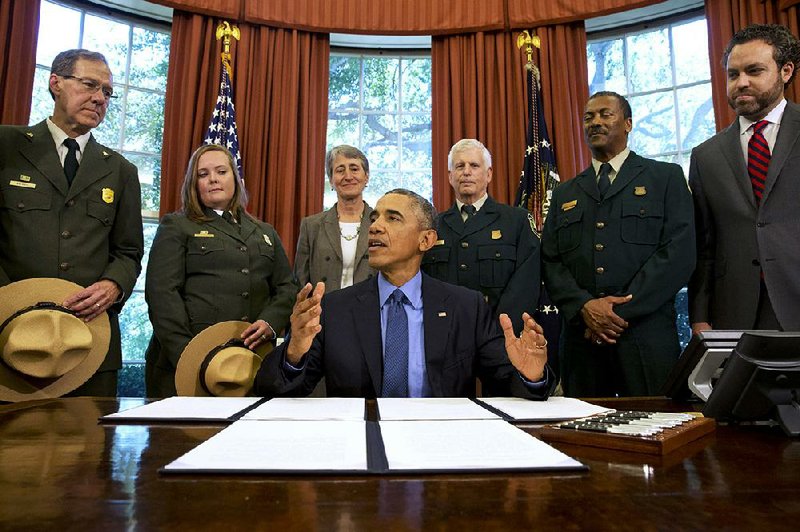WASHINGTON -- President Barack Obama designated new national monuments Friday in California, Nevada and Texas, setting aside millions of acres that are home to prehistoric rock carvings, mammoth bones and popular outdoor destinations.
The presidential move ran into immediate resistance from Republicans who accused Obama of a sneaky land grab that ignored the interests of local residents.
Obama announced a monument in the Basin and Range region of Nevada that retiring Senate Democratic leader Harry Reid has been seeking for years. He set aside more than 330,000 acres in northern California for a new monument at Berryessa Snow Mountain. Obama also declared that Waco Mammoth Site, a relatively small site in central Texas, would join the list of national monuments.
"All of them speak to some incredible history," Obama said as he formally designated the new monuments.
The three new sites raise to 19 the number of monuments Obama has created or expanded since taking office. Under the 1906 Antiquities Act, presidents have broad authority to designate historic or ecologically significant sites without congressional approval, protecting those areas from new development like mining, oil wells and grazing.
Obama has used that authority aggressively as he's worked to secure a legacy of protecting the environment and warding off the effects of climate change. Environmental advocates hailed the new monuments as bringing needed protection to natural American treasures that future generations will be able to enjoy.
"This is a gift to all Americans," said Sharon Buccino of the Natural Resources Defense Council.
But some Republicans decried the move. House National Resources Committee Chairman Rob Bishop, R-Utah., said Obama had "shown complete disdain for Congress and the people of Nevada, California, and Texas."
"I condemn this shameful power move which makes states and citizens fearful that the federal government can invade at any time to seize more lands like bandits in the night," Bishop said.
In anticipation of Obama's move, this week Nevada Rep. Cresent Hardy introduced an amendment to an Interior Department bill that would block Obama from creating monuments in areas with local opposition.
His amendment made its way into the bill on a 222-206 vote, and lists counties in Nevada, Arizona, California, New Mexico, Oregon and Utah as off-limits. The four representatives from Arkansas, all Republicans, supported the amendment.
"This Antiquities Act has been abused," Hardy said Friday. "I am a huge supporter of protecting certain lands, but I think there's a right process to go through it."
Hardy accused Obama and Reid of pushing the Nevada monument to burnish their legacies. White House spokesman Josh Earnest called Reid an "effective advocate" for making the site a monument but wouldn't say what role his advocacy played in Obama's decision.
Reid shrugged off the criticism Friday and said he believed history would favorably judge the decision.
"They know this is important to the state of Nevada," Reid said. "They're going to look back one day and say Reid was right."
The new monuments are:
• Waco Mammoth National Monument in Texas, where archaeologists have discovered remains of 24 Columbian mammoths -- the largest of the mammoth species -- from more than 65,000 years ago, according to the White House. Like other mammoths, the Columbian mammoth is now extinct, but roamed in North America during the latest ice age. The site also houses preserved remains of other ancient species, including the saber-toothed cat, dwarf antelope and the western camel.
• Basin and Range National Monument in Nevada, home to rare rock art from 4,000 years ago. The White House said more than 700,000 acres of public land will be protected in an untouched area of the Great Basin region. The site also contains "City," an array of abstract sculptures artist Michael Heizer has created for more than four decades.
• Berryessa Snow Mountain National Monument in northern California, where more than 330,000 acres will be set aside. The White House touted the area's biodiversity and American Indian cultural sites, but the area is best known as a destination for hikers, campers, fishermen and hunters. The White House said the monument would likely prompt increased visits, driving economic growth.
Information for this article was contributed by Ken Ritter of The Associated Press.
A Section on 07/11/2015
